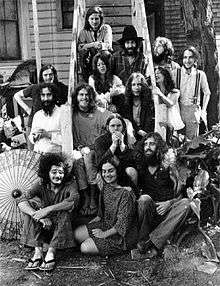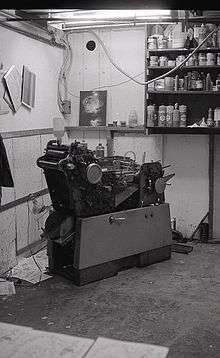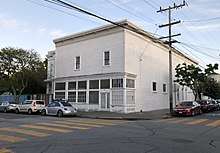Kaliflower Commune
The Friends of Perfection Commune is an American Utopian community in San Francisco, CA.[1] The San-Francisco-based commune was founded in 1967 on principles of a common treasury, group marriage, free art, gay liberation, and selfless service.[2][1][3] They were originally called the Sutter/Scott Street commune, and commonly referred to by non-members as the Kaliflower commune after their newsletter of the same name. Because of their publishing activities, which allowed them to spread their philosophy, they became a significant influence on Bay Area culture.[1] Many members of The Angels of Light, a free psychedelic drag theater group, originally lived in the Kaliflower commune.[4] The name Kaliflower came from their publication of the same name, titled after the Hindu name for the last and most violent age of humankind, the Kali Yuga.[5]
 Some members of the Scott Street Commune gathered in the backyard of the Victorian house they occupied. Photo taken in 1972. | |
| Established | 1967 (53 years ago) |
|---|---|
| Location | San Francisco |
Background
Communes played an integral part of the 1960s American hippie movement.[3] Members of the 1960s counterculture movement created new social institutions in the form of Utopian communes like Kaliflower as a way to exist outside of the hegemonic system and to resist enforced heterosexuality, the Vietnam War, capitalism, racism, mass media, and the government.[6]
The Kaliflower community was founded on the same spiritual and economic principles as the Diggers: shared property and labor and the liberation of culture from commercialism.[3] The commune's members were inspired by John Humphrey Noyes, founder of the Oneida Community, a perfectionist religious communal society that existed in New York in the 1840s, and his book, The History of American Socialisms.[3][7]
Cofounder Irving Rosenthal created the Free Print Shop, a print shop in the basement of Kaliflower, as a platform for uncensored, radical, free publishing in the Bay Area.[8]
Founder
Irving Rosenthal is a writer and editor from San Francisco.[1] He studied at the University of Chicago in the late 1950s where he was an editor of the Chicago Review.[9] There he published many Beat writers including Jack Kerouac, Edward Dahlberg, and William Burroughs but he left the Chicago Review in 1959 after the University attempted to censor an issue of the Review.[9] With the disputed material he cofounded a literary review called Big Table, which was charged with obscenity and eventually won the case,[10] adjudicated by Judge Julius Hoffman.[1][9] Irving Rosenthal moved to New York City where he continued to edit and publish beat writers before returning to San Francisco in 1967 with the intention of setting up his own publishing commune free of censorship.[1] He moved with Hibiscus, founder of the Cockettes, an avant garde psychedelic hippie theater group, and started the Kaliflower commune and the Free Print Shop.[9][11]
Commune culture
The Kaliflower spirit was one of communalism and cooperation. Many members saw their commune as their family.[1] In one issue of Kaliflower, commune members wrote, "Nuclear family members don't usually buy and sell to each other, are in fact communistic, and we wanted nuclear family intimacy among the communes".[1] It was common for members of Kaliflower to limit ties to relationships with non-communalist friends.[1] Members gave their savings to the group and were encouraged to quit outside jobs and work inside the community instead.[1] Some commune tasks included gardening, cleaning, cooking, running the Free Print Shop, maintaining a free store, or delivering the newsletter or food to other communes.[1]
The community supported a culture of polyamory, resisting attachments to a single sexual partner.[1][12] Many members slept in a group bedroom and regularly shared sexual partners, participating in what they considered to be a group marriage.[1]
Major decisions were made by consensus within the daily meeting of committed community members.[1] The commune also held voluntary criticism sessions to vent concerns with other commune members.[1] During such a session, the member who asked for criticism would invite other members to participate, and then listen in silence while concerns & criticisms were aired. Customarily the member did not respond for three days. This system of self-governance was borrowed from the 19th-century American Utopian community at Oneida, NY.[1]
Publication

Rosenthal brought his printing press to the basement of Kaliflower, and the space became known as the Free Print Shop, a free, underground publishing venue for Bay Area communes.[1][8] The flyer for the opening of the Free Print Shop announced, "The Sutter Street Commune invites you to submit manuscripts, drawings, manifestos to our Free Print Shop. Free distribution guaranteed for whatever we print."[5] From then on, the Free Print Shop produced hundreds of publication including books, pamphlets, and flyers (for free services, ecology groups, political protests, announcements for free events), Food Conspiracy order sheets, and Free Medical Clinic prescription forms.[8][5]
Starting in April 1969, members of the group worked in the print shop to create Kaliflower, the free, inter-communal newsletter.[1][5][8] The newsletter was published weekly between April 1969 and December 1971, & at longer intervals through the present.[1][5] The name was a play on Kaliyuga, the Hindu name for the last and most violent age of humankind, the idea being that the publication was "a step toward a seed of positivity growing out of the age of destruction."[5] The publication's audience grew quickly.[8] After three years, it was delivered to more than 300 communes in the Bay Area, eventually becoming so well known that the commune itself became known as Kaliflower.[1][5] Every Thursday became known as "Kaliflower Day," the day in which Kaliflower was bound and distributed. Each issue of Kaliflower was printed and bound by hand using the Japanese method of overstitching yarn on either the top or side.[8]
The newsletter began as a "inter-communal bulletin board" and became a vital mode of communication amongst the communes.[1][5] It listed items that one commune needed or had to offer; upcoming free events; announcements, free ads, and how-to and skill sharing articles.[5][8] For instance, one article from November 20, 1970 contained articles on how to build cold boxes to grow food and a recipe for squash soup.[5] One from December 10, 1970 had an article titled "Yoga Nazal Cleaning" and information on herbal hair care.[5] Over time, it came to offer a broader range of information about collective living including historical context for communalism and utopianism often citing information from the Revivalist communes in the 1820s and 1840s, most notably the Oneida Commune of John Humphrey Noyes.[1]
Free Food Conspiracy
The Free Food Conspiracy (later named the Free Food Family) was organized in 1968, in part by Kaliflower members.[1] The organization was one of the original food conspiracies, groups that pooled food stamps and other resources from participating communes and bought food in bulk which they distributed to participants on the basis of need.[13][14] By pooling resources, early food co-ops like the Free Food Conspiracy saved shopping time and provided high quality food for low bulk prices.[14] By 1973, the organization reached over 150 communes, saving money and increasing cooperation between the communes.[13] Kaliflower expressed hope that one day local communes would eventually pool enough resources to buy property and land; however the Free Food Conspiracy disbanded in 1973 due to resistance against giving up "imported cheeses and health food extravagances" in exchange for a more basic diet.[1]
Free Food Conspiracy legacy
Congress saw the Free Food Conspiracy and other resource-sharing plans like it as abuses of welfare.[1] Due to recognition of the Free Food Conspiracy and others like it by Congress the US Supreme Court struck down the commune clause under the equal protection provision of the 5th Amendment in USDA v. Moreno so that communes are no longer able to receive food stamps like other households.[1]
Although the Free Food Conspiracy disbanded in 1973, the organization spurred the creation of many food co-ops as people saw the benefits of organizing wholesale buying operations.[14] The Free Food Conspiracy was a predecessor of many anti-capitalist resource sharing programs including other cooperative food systems, bicycle repair workshops, community gardens, and farmers' markets.[1][15] It inspired the Food Not Bombs program, an all-volunteer run global movement that shares free vegan meals as a protest to war and poverty.[16] The Free Food Conspiracy also gave rise to the Really Really Free Market, a movement of temporary markets based on the gift economy where participants bring unneeded items, food, and skills like haircuts to a community space to share with other participants with the principle of countering capitalism.[15]
Impact


Kaliflower helped create the culture of Haight-Ashbury and the San Francisco hippie movement during the 1970s. The commune that produced it influenced the formation, structure, and principles of many other communes including The House of Love and Prayer[17] and the One Mind Temple (which became the St. John Coltrane Church).[18] Its existence continues to inspire the creation of other utopian, anti-capitalist communes and resource-sharing groups with similar values.
In 1974, the commune moved to the Mission District at 23rd and Shotwell Streets and became a new organization, Rebirth and Development.[19] As of 2011, it continues to host services such as a food pantry, referrals to free services, and a free community garden.[19] As of 2015, the community garden (All in Common Garden) supported the Free Farm Stand on Sundays at Parque Niños Unidos at 23rd and Treat Streets,[20] which is organized by a person who was part of the commune.[21]
Representation in media
Kaliflower is referenced in The Cockettes, a film by David Weissman and Bill Weber about a psychedelic, San Francisco based, gender-bending theater group founded by Hibiscus, one of the first members of the Kaliflower commune.[11]
Kaliflower is mentioned in The Fabulous Sylvester: The Legend, the Music, the Seventies in San Francisco, a biography by Joshua Gamson about the life of Sylvester, a queer, American singer and performer popular for his disco music.[22] Sylvester did not live at the Kaliflower house, but another cofounder of the Cockettes, Hibiscus, had been part of Kaliflower.[23]
References
- Carlsson, Chris; Elliott, Lisa Ruth (2011-06-01). Ten Years That Shook the City: San Francisco 1968-1978. City Lights Books. ISBN 9781931404129.
- "Rosenthal, Irving, 1930-..." socialarchive.iath.virginia.edu. Retrieved 2017-03-23.
- Miller, Timothy (1999-01-01). The 60s Communes: Hippies and Beyond. Syracuse University Press. ISBN 9780815606017.
- Kaliflower, vol. I, no. 38, Jan. 8, 1970
- "Kaliflower: the Intercommunal [Free] Newspaper, A Publication of The Free Print Shop". The Digger Archives Home Page. Retrieved 2018-07-16.
- Perry, Charles; Weir, Bob (2005-09-01). The Haight-Ashbury: A History (1st ed.). New York; London: Wenner. ISBN 9781932958553.
- "BOMB Magazine — Mary Jordan by Nayland Blake". bombmagazine.org. Retrieved 2017-04-27.
- Keats, Patricia L. (1998-08-08). "Kaliflower and The Free Print Shop". California Chronicle / calhist.org. Archived from the original on 1998-12-06. Retrieved 2020-02-12.
- "Rosenthal, Irving, 1930-..." socialarchive.iath.virginia.edu. Retrieved 2017-04-27.
- "Big Table, Inc. v. Schroeder, 186 F. Supp. 254 (N.D. Ill. 1960)". Justia Law. 1960-06-30. Retrieved 2019-02-18.
- "A Brief History..." The Cockettes. 2012-10-10. Retrieved 2019-01-14.
- "Communalism in San Francisco - FoundSF". www.foundsf.org. Retrieved 2017-04-27.
- Curl, John (2009-09-01). For All the People: Uncovering the Hidden History of Cooperation, Cooperative Movements, and Communalism in America (1 ed.). Oakland, CA: PM Press. ISBN 9781604860726.
- "A Personal History of the Peoples Food System - FoundSF". www.foundsf.org. Retrieved 2017-04-27.
- "San Francisco Bay Area Flea Markets (top 10) - San Francisco Really Really Free Market (RRFM), San Francisco - Flea Market InsidersFlea Market Insiders | Page 9". www.fleamarketinsiders.com. Retrieved 2017-04-27.
- "San Francisco Food Not Bombs". San Francisco Food Not Bombs. Retrieved 2017-04-27.
- Kroll-Zeldin, Oren (2017-12-09). "Everyday Life at the House of Love and Prayer". The House of Love and Prayer: A Radical Jewish Experiment in San Francisco. Retrieved 2019-02-17.
- "Digger Bread & The Free Bakery (ies)". The Digger Archives. Retrieved 2019-02-17.
- Goldberg, Jamie (2011-12-29). "Odd Buildings: A Hidden Charity on 23rd Street". Mission Local. Retrieved 2019-02-17.
- Rustrum, Chelsea. "How to Create a Free Farm Stand in Your Community". Shareable. Retrieved 2019-02-17.
- Whittaker, Richard (2012-04-16). "Conversations.org: A Conversation with Tree (Dennis Rubenstein), by Richard Whittaker". Works and Conversations. Retrieved 2019-02-17.
- Gamson, Joshua (2006-01-24). The Fabulous Sylvester: The Legend, the Music, the Seventies in San Francisco (Reprint ed.). New York: Picador. ISBN 9780312425692.
- Gamson, Joshua (2006-01-24). The Fabulous Sylvester: The Legend, the Music, the Seventies in San Francisco. Macmillan. p. 75. ISBN 9780312425692.
External links
- Free Print Shop home page

- "Conversations.org: A Conversation with Tree (Dennis Rubenstein), by Richard Whittaker". Conversations.org. 2012-04-16. Retrieved 2018-07-17.